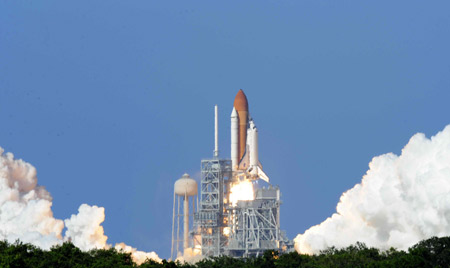US space shuttle Discovery, with seven astronauts aboard, soared into space at 5:02 p.m. EDT (2102 GMT) on Saturday as scheduled from its seaside launch pad at the Kennedy Space Center in Florida.
"Best of luck to the International Space Station's newest laboratory!" NASA launch commentator Allard Beutel broadcasted.

U.S. space shuttle Discovery soars into space at 5:02 p.m. EDT (2102 GMT) on Saturday as scheduled from its seaside launch pad at Kennedy Space Center in Florida.(Xinhua Photo)
The afternoon weather in this Atlantic coastal area cooperated fairly with clear skies and a comfortable breeze.
Several minutes after the liftoff, controllers confirmed a good solid rocket booster separation and external fuel tank separation. "It's a flawless ascent," said the ground control center. Discovery is "in its preliminary orbit," and it will chase the space station during the next two days.
At the post-launch, NASA administrator described the launch day as a "huge day," with everything going extremely smoothly.
Led by Commander Mark Kelly, the six-man, one-woman Discovery crew includes Akihiko Hoshide, who represents the Japan Aerospace Exploration Agency (JAXA).
U.S. space shuttle Discovery soars into space at 5:02 p.m. EDT (2102 GMT) on Saturday as scheduled from its seaside launch pad at Kennedy Space Center in Florida.(Xinhua Photo)
The main goal of Discovery's STS-124 mission is to deliver the main part -- Pressurized Module -- of JAXA's Kibo (which means " hope" in Japanese) laboratory to the station.
This is the second of three flights that will launch components to complete Kibo,which is Japan's primary contribution to the ISS program.
The Pressurized Module of Kibo is 37 feet long and 14.4 feet in diameter, about the size of a large tour bus. It will be the biggest room once installed at the orbital outpost.
After linkup with the ISS, the shuttle and station crew will install Kibo science module to the left side of the Harmony connecting node, opposite to the European Columbus science lab that was installed in February.
They will also assemble Kibo's remote manipulator system, which consists of two robotic arms that supports operations outside of Kibo.
The lab's logistics module, which was installed in a temporary location during a shuttle mission in March, will be relocated to Kibo's new science module.
Also inside Discovery's payload bay is a new toilet pump for the ISS to fix its balky toilet.
The new pump and some related parts were rushed in from Russia to the United States just two day before Discovery's launch. NASA shuttle managers have to try to make room in the jam-packed payload bay for the half-meter-long pump.
The commode on the station is acting up recently. For the past week, the two Russian and one American men have had to periodically manually flush the urine side of the Russian-built toilet. The job takes 10 minutes and requires two people, which makes the life up there quite inconveniently.
NASA is also squeezing in the payload bay with a Disney toy, Buzz Lightyear. The action figure popularized with the 1995 movie Toy Stoy, and now aboard space shuttle Discovery, its dream of going "to infinity and beyond" will finally come true.
The toy will fly in zero gravity inside the station for several months as part of NASA's "Toys in Space" initiative.
Dicovery's mission is designated as STS-124. During the planned 14-day mission, astronauts will carry out three spacewalks to assemble Kibo's new module and its robotic arm system.
Space Shuttle Discovery will also deliver a new crew member to the orbital outpost. Mission Specialist Gregory Chamitoff will replace Garrett Reisman, the American who arrived on the station in March and is completing three months as a station flight engineer. Reisman will return to Earth aboard Discovery, and Chamitoff will stay up there for six months as a part of the Expedition 17 space station crew.
This is NASA's third shuttle flight in 2008, the 26th flight to the space station. NASA has about 10 more flights to complete construction of the 100-billion U.S. dollars multinational space station program. It also plans to fly a final servicing call to Hubble Space Telescope, which is scheduled on October 8.
The three active service space shuttles -- Discovery, Endeavour and Atlantis -- are set to retire in 2010.
(Xinhua News Agency June 1, 2008)